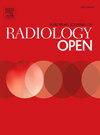前列腺癌筛查的联合预测模型:开发和验证研究
IF 2.9
Q3 RADIOLOGY, NUCLEAR MEDICINE & MEDICAL IMAGING
引用次数: 0
摘要
背景前列腺癌(PCa)的检测仍然具有挑战性,因为前列腺特异性抗原(PSA)检测和直肠指检(DRE)的特异性有限。经直肠超声(TRUS)通常用于活检指导,但其在前列腺癌筛查中的诊断潜力尚未得到充分探索。我们的目的是评估TRUS衍生的形态学特征,并开发一个整合临床和TRUS特征的nomogram,以改善PCa的风险分层。方法从两个三级中心连续招募疑似PCa患者(培训队列:n = 154,2021年10月- 2023年1月;验证队列:n = 51,2021年12月- 2022年6月)。收集和分析人口统计数据、实验室衍生的PSA指数(包括PSA密度)和TRUS参数(由两名盲法超声医师独立评估)。采用多元逻辑回归构建预测模态图,并进行外部验证。ResultsIn训练队列(平均年龄70.9 ± 8.0年;72 PCa, 82良性),PCa的独立预测因子包括高PSA密度(或= 3.86,95 % CI: 1.30 - -11.40, P = 0.015),异常DRE(或= 3.06,95 % CI: 1.09 - -8.60, P = 0.034),TRUS-defined模糊区边界(或= 9.61,95 % CI: 3.37 - -39.02, P = 0.002),和hyper-enhancement(或= 7.07,95 % CI: 2.69 - -21.89, P & lt; 0.001)。nomogram具有较强的判别性(training C-index=0.933, 95 % CI: 0.881-0.986; validation C-index=0.907, 95 % CI: 0.792-0.970), sensitivity为84.7 %,specificity为87.8 %,accuracy为86.4 %。病理一致性高(kappa=0.726)。结论trus衍生特征(区域不清、超增强)结合临床参数可显著提高前列腺癌的检出率。我们的图提供了一个实用的、可视化的工具来指导活检的决定,并在队列中展示了强大的性能。本文章由计算机程序翻译,如有差异,请以英文原文为准。
Combined predictive model for prostate cancer screening: Development and validation study
Background
Early detection of prostate cancer (PCa) remains challenging, as prostate-specific antigen (PSA) testing and digital rectal examination (DRE) offer limited specificity. Transrectal ultrasound (TRUS) is routinely used for biopsy guidance, but its diagnostic potential for PCa screening is underexplored. We aimed to evaluate TRUS-derived morphological features and develop a nomogram that integrates clinical and TRUS characteristics to improve PCa risk stratification.
Methods
Consecutive patients with suspected PCa were enrolled from two tertiary centers (training cohort: n = 154, October 2021–January 2023; validation cohort: n = 51, December 2021–June 2022). Demographic data, laboratory-derived PSA indices (including PSA density), and TRUS parameters (independently assessed by two blinded sonographers) were collected and analyzed. A predictive nomogram was constructed using multivariate logistic regression and externally validated.
Results
In the training cohort (mean age 70.9 ± 8.0 years; 72 PCa, 82 benign), independent predictors of PCa included elevated PSA density (OR=3.86, 95 % CI: 1.30–11.40, P = 0.015), abnormal DRE (OR=3.06, 95 % CI: 1.09–8.60, P = 0.034), TRUS-defined ill-defined zone boundaries (OR=9.61, 95 % CI: 3.37–39.02, P = 0.002), and hyper-enhancement (OR=7.07, 95 % CI: 2.69–21.89, P < 0.001). The nomogram achieved strong discrimination (training C-index=0.933, 95 % CI: 0.881–0.986; validation C-index=0.907, 95 % CI: 0.792–0.970) with 84.7 % sensitivity, 87.8 % specificity, and 86.4 % accuracy. Pathological concordance was high (kappa=0.726).
Conclusion
TRUS-derived features (ill-defined zones, hyper-enhancement) significantly enhance PCa detection when combined with clinical parameters. Our nomogram provides a practical, visual tool to guide biopsy decisions and demonstrates robust performance across cohorts.
求助全文
通过发布文献求助,成功后即可免费获取论文全文。
去求助
来源期刊

European Journal of Radiology Open
Medicine-Radiology, Nuclear Medicine and Imaging
CiteScore
4.10
自引率
5.00%
发文量
55
审稿时长
51 days
 求助内容:
求助内容: 应助结果提醒方式:
应助结果提醒方式:


